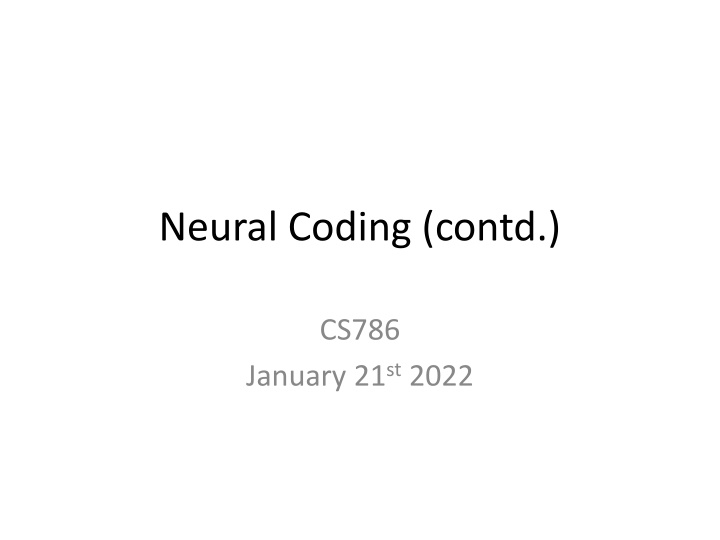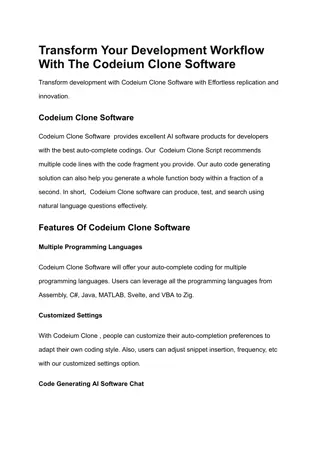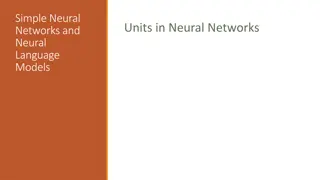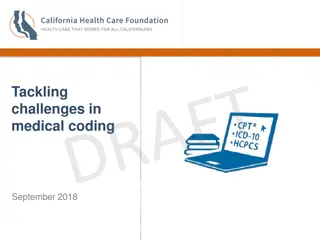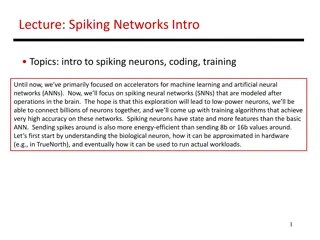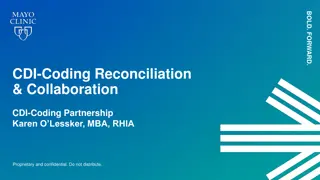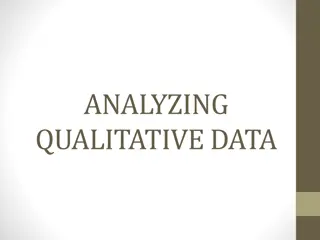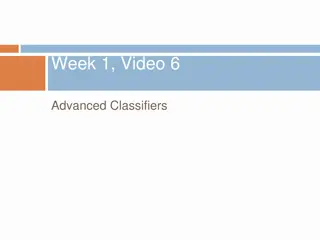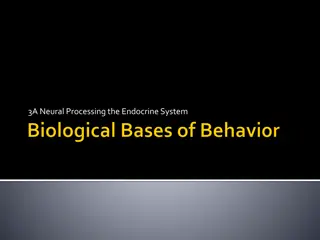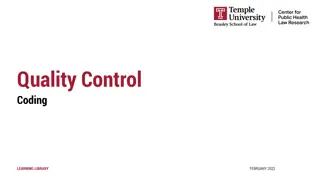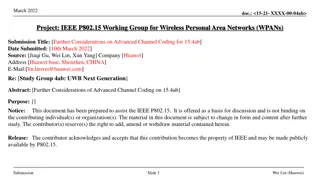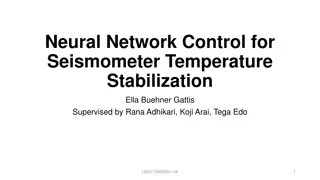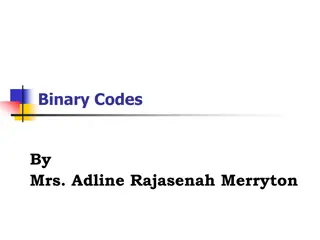Neural Coding (contd.)
In neural coding, organisms use vector coding to represent sensory inputs. Different forms of coding - compact, local, distributed - and species-specific saliency are discussed. The content delves into sensorimotor coordination, mapping thoughts to actions in the brain, and the complexities of neural representations. The comparison of coding forms sheds light on how different animals process sensory information. The intricate relationship between sensory stimuli and motor responses is explored, highlighting the intelligent physical behavior exhibited by organisms in response to their environments.
Download Presentation

Please find below an Image/Link to download the presentation.
The content on the website is provided AS IS for your information and personal use only. It may not be sold, licensed, or shared on other websites without obtaining consent from the author.If you encounter any issues during the download, it is possible that the publisher has removed the file from their server.
You are allowed to download the files provided on this website for personal or commercial use, subject to the condition that they are used lawfully. All files are the property of their respective owners.
The content on the website is provided AS IS for your information and personal use only. It may not be sold, licensed, or shared on other websites without obtaining consent from the author.
E N D
Presentation Transcript
Neural Coding (contd.) CS786 January 21st2022
Vector Coding An organism s sensory apparatus uses vector coding as a representation of its inputs. Semi-local coding, since the components of a conjunctive concept are localized to individual neurons. A particular color, flavor, sound, etc. = a vector of receptor states (not a single receptor state). Combinatorics: nkpossible vector states, k = # receptors, n = # possible receptor states. Note: n > 2 in many cases. The fact that humans are much better at disciminating sensory inputs than actually describing them illustrates the relative density of sensory vector space -vs- the sparseness of language. 0.1 0.8 0.2 0.9 ``Tyrkisk Pebel Tongue
Comparison of Coding Forms Compact Representation: Local (NO!), Distributed (YES!) Graceful Degredation (Code works when a few neurons are faulty): Local (NO!), Distributed (Yes- due to redundancy). Binding Problem (How to represent two concepts that occur simultaneously): Local (EASY! - two active nodes), Distributed (HARD - but may be possible by quick shifts back and forth between the 2 activation patterns) In more complex animals, all 3 coding forms are probably present, with local for the most salient concepts for that organism.
Species-Specific Saliency The key stimuli for an organism are often locally or semi-locally encoded, with direct connections from the detector neuron(s) to a motor (action-inducing) neuron. The movement of this simple pattern ressembles a hawk and scares small chickens. The movement of the reverse pattern ressembles a goose and elicits no response from the chicks.
Fish Dinner Three-spined sticklebacks respond to these simple stimuli: But not these: Salient feature: Red belly!
Sensorimotor Coordination: Mapping Sensations to Actions Brain Output vector of desired muscle activation levels Input vector Muscles Senses Intelligent Physical Behavior: Performance of the proper motor movements in response to the current sensory stimuli. A large and well-defined brain is just evolution s latest and highest achievement in sensorimotor coordination, not its earliest or only example Churchland, pg. 95-6 Vector processing: Transformation of sensory input vectors into motor output vectors Coordinated Behavior: Proper sequence of muscle-activations = proper trajectory in output-vector space. XC Ski Walk Run
Mapping Thoughts to Actions in the Brain The cerebellum, which controls a good deal of motor activity, has a feed-forward structure with few backward (i.e., recurrent) connections. The cerebrum sends commands to initiate action, which are fed forward from mossy to granule to parallel to Purkinje and out to motor neurons. Parallel Fibers *Arrows denote signal direction Granule Cell Purkinje Cell Thought Cerebral Neocortex Mossy Fiber Climbing Fiber To motor cortex (Action!) From inferior olive
Distributed Coding in the Motor Cortex Cortical area # 4 = The Motor Cortex (M1) Pyramidal cells in M1 get inputs from the cortex & thalamus; they send outputs to motor neurons. But pyramidals => motor neurons is an N-N mapping. So during any particular movement, MANY pyramidal and motor neurons are firing. I.e. Movement coding is DISTRIBUTED across the pyramidal cells. A Firing Rate B Pyramidal Cells A B Motion Angle Motor Neurons
Associative-Memory Networks Input: Pattern (often noisy/corrupted) Output: Corresponding pattern (complete / relatively noise-free) Process 1. Load input pattern onto core group of highly-interconnected neurons. 2. Run core neurons until they reach a steady state. 3. Read output off of the states of the core neurons. Inputs Outputs Output: (1 -1 1 -1 -1) Input: (1 0 1 -1 -1)
Distributed Information Storage & Processing wi wj wk Information is stored in the weights with: Concepts/Patterns spread over many weights, and nodes. Individual weights can hold info for many different concepts
Hebbs Rule Connection Weights ~ Correlations ``When one cell repeatedly assists in firing another, the axon of the first cell develops synaptic knobs (or enlarges them if they already exist) in contact with the soma of the second cell. (Hebb, 1949) In an associative neural net, if we compare two pattern components (e.g. pixels) within many patterns and find that they are frequently in: a) the same state, then the arc weight between their NN nodes should be positive b) different states, then arc weight between their NN nodes should be negative Matrix Memory: The weights must store the average correlations between all pattern components across all patterns. A net presented with a partial pattern can then use the correlations to recreate the entire pattern.
Correlated Field Components Each component is a small portion of the pattern field (e.g. a pixel). In the associative neural network, each node represents one field component. For every pair of components, their values are compared in each of several patterns. Set weight on arc between the NN nodes for the 2 components ~ avg correlation. a a ?? ?? b b Avg Correlation wab a b
Hopfield Nets in the Brain The cerebral cortex is full of recurrent connections, and there is solid evidence for Hebbian synapse modification there. Hence, the cerebrum is believed to function as an associative memory. Flip-flop figures indicate distributed hopfield-type coding, since we cannot hold both perceptions simultaneously (binding problem)
The Necker Cube H E Which face is closer to the viewer? BCGF or ADHE? G F D A Only one side of the (neural) network can be active at a time. B C Closer(A,B) Closer(H,G) Closer(G,H) Closer(C,D) Convex(A) Hidden(G) Showing(G) Convex(G) Excitatory Inhibitory Steven Pinker (1997) How the Mind Works , pg. 107.
Whats in a Link? An implicit coding of the preferences that a node has for upstream values. An implicit coding of the correlation between the data elements represented by the two nodes. +2 +6 A +1 a +7 B Correlation -3 C b +5 X Y .5 .5 1 1 -.5 -.5 H E -.8 -.8 and and G .5 .5 F 1 D A or .3 B C
Architectures & Node/Link Semantics Feedforward Networks & Competitive Networks Nodes = Semi-local or local coding of low-level and high-level concepts Arcs = Preferred upstream values; I.e. preconditions for concept membership. (The inter-layer inhibitory arcs in competitive networks embody the control information that only one node can win/fire) In Out In Out Hopfield Networks Nodes = Semi-local or distributed coding for elements of the input pattern Arcs = Average correlations (across many patterns) between the input elements represented by the arc s 2 nodes. The inter-layer nodes are just for transferring the inputs to the clique. In Out
